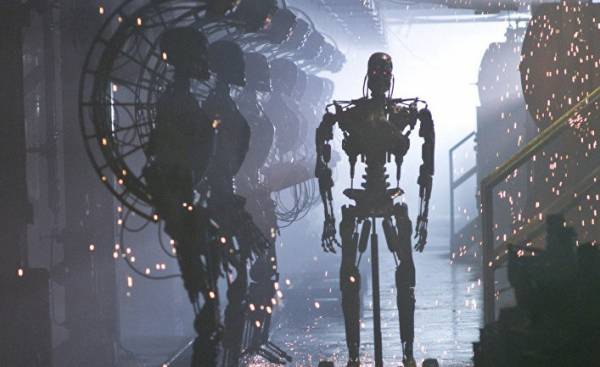
From 1983 to 1993, the Office of advanced research and development of the Ministry of defense (DARPA) spent more than a billion dollars on a program called Strategic Computing Initiative (Strategic computer initiative, or SCI). The goal of DARPA was to expand the boundaries of computers, artificial intelligence and robotics, to create something new, is very reminiscent of the dystopian future of Terminator. It wanted to create Skynet.
As the Star wars program Ronald Reagan, the idea of SKI was too futuristic for its time. But today, when we see the startling successes in creating the military of artificial intelligence and Autonomous robots, it makes sense to return to this half-forgotten program and ask yourself the question: are we willing to live in a world linked by electronic brain of killing machines? And perhaps a useless question. If we want to stop this, if we were not late with your desire?
“The possibilities are truly staggering…”
If a new generation of technology will develop as we expect, there will be unique new opportunities for the application of computers in the military. For example, instead of adopting a simple guided missiles or aircraft with remote control you can launch completely Autonomous land, sea and air vehicles able to perform complex and diverse tasks of conducting reconnaissance and strikes. The possibilities are truly staggering, and they say that the computers of new generation will radically change the nature of future conflicts.
This is an excerpt from a little-known document, presented in October 1983, Congress. It sets out objectives for the new Strategic computer initiative. As everything else than DARPA did before and after the programme was extremely ambitious.
The concept of Strategic computer initiative was implemented in a completely new system, the development of which was headed by Robert Kahn (Robert Kahn), who led at the time by DARPA in the Department of methods of processing information. As reported in the published in 2002 the book “Strategic Computing” (Strategic computing), Kahn is not the first made a presentation about this system, however, “he first presented the concept and structure of the future Strategic computer initiative. He started this project and defined its contents at an early stage. SKI has acquired a life of its own, it was led by other people, but it preserved the influence of the cane.”
This system was to create a world where separate devices are not only collecting intelligence about the enemy around the world, but have the potential with deadly accuracy to strike from land, sea and air. SKI had become a global network connecting all aspects of military-technical potential of the U.S. potential based on the new and incredibly fast computers.
But this network was intended not just for cold and impartial automated information processing. No, the new system was to see, to hear, to act and react. And most importantly, she had to understand, and without any prompting from the human.
Economic arms race
The origin of the SKI is often associated with technological competition that arose between the United States and Japan in the early 1980-ies. The Japanese wanted to create a new generation of supercomputers, which were to form the basis of artificial intelligence system. By combining the economic power of the Japanese state and the new capabilities of the microelectronics and computer industry, they achieve their goal started to create a computer system of the fifth generation.
The goal was to develop incredibly fast computers, allowing Japan to break away from other countries (primarily the United States and from there the nascent “Silicon valley”) in the race for technological superiority. To perform this task, the Japanese have given yourself 10 years. But no matter how they accelerated their cars, they, like the Americans, failed to make computers “smarter” due to the powerful artificial intelligence.
Japanese aspirations frightened many Americans. They were concerned that America is losing its leading technological position. These fears are largely fueled published in 1983 the book by Edward Feigenbaum (Edward A. Feigenbaum) and MacCormack Pamela (Pamela McCorduck) “The Fifth Generation: Artificial Intelligence and Japan’s Computer Challenge to the World” (the Fifth generation. Artificial intelligence and Japanese computer challenge to the world), which became mandatory reading literature on Capitol hill.
To popularize the ideas SKI among the American people and the business community, DARPA insisted that the purpose of the initiative from the very beginning is only to the promotion of the economic interests of the country. Side effects from this technology was to create new incentives for the US economy, as reported in the document DARPA planning:
Computer technology the new generation coming into the industry of household electronics, creating an internal market for applications of machine intelligence.
Appeal to the private sector and the University system also needed to provide assistance to the most intelligent and talented in the fulfillment of the program objectives of the office of advanced research and development:
No less important is the transfer of these technologies into industry to create the human resource base of engineers and systems builders familiar with computer science and the technologies of machine intelligence, today work and study in leading University laboratories, and the application of these new technologies the range of products of various companies. To this end, we will make full use of the regulating norms and rules of public procurement related to the protection of corporate proprietary information, trade secrets, patent rights, standards, licensing and royalties.
And what is the conclusion? The government gave guarantees to the private sector that the developed technology will not be transferred to the companies-competitors.
But economic competition with the Japanese, even were the important motive, caused only a secondary concern to the politicians, entangled in the vicissitudes of the cold war. The hawks of the Republican party were mostly concerned with military construction and military buildup. Many of them believed that the most important military threat from the Soviet Union. And Strategic computer initiative was to avoid that danger.
The connection with Star wars
The program is run, SKI and technical specifications of DARPA, appeared in 1983 and 1984, has caused sharp debate in the scientific community — the one which ultimately has benefited from funding under this project. Some expressed doubts about the feasibility of ambitious plans to create advanced artificial intelligence. Someone was worried about the fact that with the creation of artificial intelligence for military purposes will begin a terrible era of independent armies of robots.
And it was quite reasonable concern. If the purpose of Star wars (a popular name for the Strategic defense initiative of Ronald Reagan and a popular political football of the time) it’s automatic or semi-automatic response to any missile and nuclear threat from the Soviets, it would be ridiculous not to include it in a larger system truly intelligent machines. The tasks of the two projects, not to mention developed their institutions, too largely coincide and overlap to be a coincidence, although each insisted that this is a coincidence.
From the work of Chris Habla gray (Chris Hables Gray), written in 1988:
Command and control system of Star wars, which is probably the most difficult and most ambitious software project in history, the conceptual (but not administrative) is part of the Strategic computer initiative. To make a scientific breakthrough in computing, a much-needed SOY is a key goal of the SKI.
If you ask anyone who worked in the program guide SKI, you will be talking about what Strategic computer initiative had nothing to do with the dream of Reagan’s Star wars. But people from the outset, a SKI carried out a connection between her and SOYBEANS. In part, these associations arose because of the similarity in names and because of the fact that these names gave them one man — Robert Cooper (Robert Cooper), who held the position of Director of the office of advanced research and development of the Ministry of defense from 1981 to 1985. Maybe people saw the link to that developed for the SKI computer systems, pairing, logically approached as an application for space and missile defense strategy.
Implementation of strategic computer technology on land, at sea and in the air
Prepared in 1983, the General pattern of the SKI outlined the objective of the initiative. The goal was clear and simple: to develop a broad base of technologies of artificial intelligence to enhance national security and economic strength. But to achieve this, Congress and the military departments, which were in future to use the TRC and its benefits, it was necessary to see this system in action.
The SKI had three hardware realization, which had to prove its combat potential, although by the end of 1980-ies it was assumed to develop more such systems. At the forefront of technical developments SKI was the Autonomous land vehicle ALV, “assistant pilot” and the command and control system of an aircraft carrier.
These funds are planned to be equipped with incredibly advanced computers that was designed in Cambridge, the company BBN, best known for his work on creating the first version of the Internet. Computers made it possible to achieve breakthrough success in the areas of vision systems, language understanding and navigation. And these are the most important tools to create an integrated military force of the man-machine.
Car without driver — 1985
The most outwardly sinister product, emerged from the bowels of the SKI, it was the Autonomous land vehicle ALV. This eight-car without a driver was three meters in height and four in length. He was equipped with camera and sensors that were mounted on the roof and managed the movement of the machine, being its “eyes.”
Martin Marietta teamed in 1995 with Lockheed Corporation, which led to Lockheed Martin, in the summer of 1984 won the tender for the construction of an experimental Autonomous ground vehicle. For three and a half years of implementation of the programme of SKI she was to receive $ 10.6 million (adjusted for inflation this amounts to 24 million) plus 6 million additionally, if the project is to meet certain benchmarks.
The room Popular Science in October 1985, an article appeared about the trials, which were held at a secret landfill Martin Marietta southwest of Denver.
Author Jim Schefter (Jim Schefter) described the stage of tests:
Korobkovsky blue and white car slowly and gradually moves on a narrow road in the valley of the Colorado, not daring to stray too far from the centerline. The only window that is similar to the eye of the Cyclops, set on the frontal side of the machine, but the driver was not seen. She moves cautiously, almost stealthily, which seems a little inappropriate for this eight-wheel, three-meter height of the vehicle. Although it has three growling of the diesel engine, the car travels slowly at a speed less than five miles per hour.
After about a mile, clumsy the machine stops. But from it no one goes. Just in the car there is no one — alone computer. Using laser and camera as the eye, experimental, but already very sophisticated artificial intelligence program is driving on the road without human intervention.
DARPA has combined the efforts of Martin Marietta and the University of Maryland, who conducted the big work on creation of technical vision systems. This Association seemed to be important for success in the development of a ground vehicle.
To create a vision system for Autonomous vehicle proved to be incredibly difficult. It can mislead light and shadow, and therefore reliability it was insufficient. Day the road side, she found no problems, but due to evening shadows in the sunset she could slide into a ditch.
Any changes in the environment (for example, dirt from the wheels of the other car) was also hit by a vision system off. This was unacceptable even in test conditions at the site. If the machine cannot cope with such simple obstacles, how it will operate in complex and unpredictable battle with the myriad of variables?
By November 1987, the Autonomous ground vehicle was significantly enhanced, however, by the end of the year it actually declined. Although the machine was fairly primitive, some experts from DARPA considered that it is too quickly dismissed.
In the end, she was unable to overcome his lack of preparedness for battle. As noted by Alex Roland (Alex Roland) in his book “Strategic Computing”, “one officer, who did not understand the concept of the ALV program, complained that the car is militarily completely useless: very slow and white, which makes it an easy target on the battlefield”. In April 1988, the Office of advanced research and development has officially stopped working on it.
R2-D2, but in real life
The second practical implementation of a Strategic computer initiative was the “assistant pilot.” The developers imagined it as an invisible robot R2-D2 is a smart companion that understands the simple language of the pilot. Assistant this could, for example, to detect enemy target and ask the pilot whether to destroy it. Something like “Best shooter” in the company personal assistant Siri from the iPhone.
In this scenario, the final decision was left to the pilot. But his assistant was supposed to be smart enough not only to know who is asking the questions that he asked and how to ask questions yourself. He had to understand why.
Here are the lines from the document SKI planning:
On the pilot in combat dumped a huge amount of information, he is constantly in touch, and on this basis must make decisions that often affect his life. He also has a huge number of buttons, switches, and keys on the panels and handles control of which requires clarity and precision. Each of the hundreds of parts designed for their own, well-defined and important goals, but their underlying technologies are far ahead of our ability to competently and reasonably to establish the interaction between these components and a pilot.
And it was here that the Office of advanced research and development and decided that he needed a “Skynet”. New features of the fighting associated with the rapid development of military technology, demanded a clear interaction of machine and man — and that was the key to success in battle. The pilot still pushing the buttons, but these computers had to think for him at least halfway. If humanity does not have time, it is necessary to connect to the machine.
The program “assistant pilot” is not reported in the American press to the same extent that Autonomous ground vehicle. Perhaps it was due to the fact that it was much more difficult to imagine than a huge, traveling on the road without driver tank. But if you look at the current technologies of speech recognition, it becomes clear what led to all this research “assistant pilot.”
Invisible robot-EA
Command and control system became the third practical embodiment of the SKI program designed to prove its feasibility.
Here he writes about Roland in the book “Strategic Computing”:
At the naval complex command and control SKI system with artificial intelligence was to make inferences about the enemy and their troops, combat troops and military order of the uncertainties, to develop options strikes, to carry out simulation modeling to assess these options, to develop operational plans and to submit arguments and explanations.
Command and control system was essentially the brains of the operation, and for this reason it was kept secret, in contrast to the ALV. Riding on the road without a driver robot can scare many. Invisible robot with an invisible finger on the nuclear button? Well, to publish press releases on this subject hardly anyone wants.
Command and control system was designed as a software application specifically for the Navy. (Autonomous land vehicle was created specifically for the army, and “assistant pilot” for the air force.) But really, it was just a smokescreen for a more universal system. All of these technologies would be used in the future where they will be most necessary. Designed for the “assistant pilot” the voice recognition program was planned to be used in all types of armed forces, not only in the air force. A command and control system had to fit all — except, of course, the enemy.
Collect Skynet together
All the various components of the Strategic computer initiative was part of a larger hypothetical system that could radically change the nature of war in the twenty-first century.
Imagine a global wireless network, which controls many other subordinate networks in the U.S. armed forces. Imagine how an army of robotic tanks, talking to the swarms of drones in the skies and submarines without crews at sea and the interaction between them is much faster than it could make any team-man. Now imagine that all of this is a lot harder with nuclear missiles, waiting for launch into space.
The concept of Strategic computer initiative was incredibly bold, and along with that a little strange to think about how far she could get. The logic of further development of artificial intelligence and global network of killing machines is not difficult to imagine though, because we have no account seen it in books and movies.
The future of war and peace
Strategic computer initiative in the early 90s, it completely destroyed the realization that to create a powerful artificial intelligence like that imagined by DARPA, is simply impossible. But if all these developed in the 1980-ies technology and technical innovations seem to us strangely familiar, it is because of the fact that they are at the beginning of the XXI century spoken and written media.
The vision system of the Autonomous land vehicles is embodied in robots like Atlas company Boston Dynamics. We see that the speech recognition system of the type of Siri “assistant pilot” is used in the U.S. air force. And the Autonomous machine is experiencing, Google along with many other firms. All of this — technology wars of the future. And if you believe Google, this is a technology world of the future.
Google recently bought Boston Dynamics, and it caused great surprise to those who are concerned about the future army of independent robots. Google says that Boston Dynamics will honour all his old contracts with military clients, but to sign a new will not.
But whether or not Google is taking orders from the military (which is entirely possible, because they can do it in secret, using funds from its “black” budget), there is no doubt that the border between civil and military technology has always been blurred. If Boston Dynamics never again will work with organizations like DARPA, but Google will benefit from research funded by the military, it seems possible to say that the system works.
The military got what they needed, promoting research in the field of robotics through a private company. And now the results of these military technologies will make themselves felt in our daily civil life like many other technologies, including the Internet.
The truth is, this article provides only a drop in the bucket of those plans that the Office of advanced research and development nurtured in the framework of the SKI. We hope that by continuing to explore yesterday’s vision, we will be able to find a historical experience and a better understanding of what our new achievements came not from the air. They even innovations is not always possible to call. It is the result of years of research and billions of dollars of appropriations that have mastered hundreds of organizations, both public and private.
Ultimately, Strategic computer initiative was eliminated not because of the fear of what it can bring to our world. Just the technology for its realization have evolved quickly enough — when it comes to artificial intelligence, and Autonomous vehicles. But for twenty years since the collapse of SKI all of these developing intelligent machines continued.
The future with a very intelligent and interconnected robots almost became real. We don’t have to love him, but we can’t say we were not warned about it.







